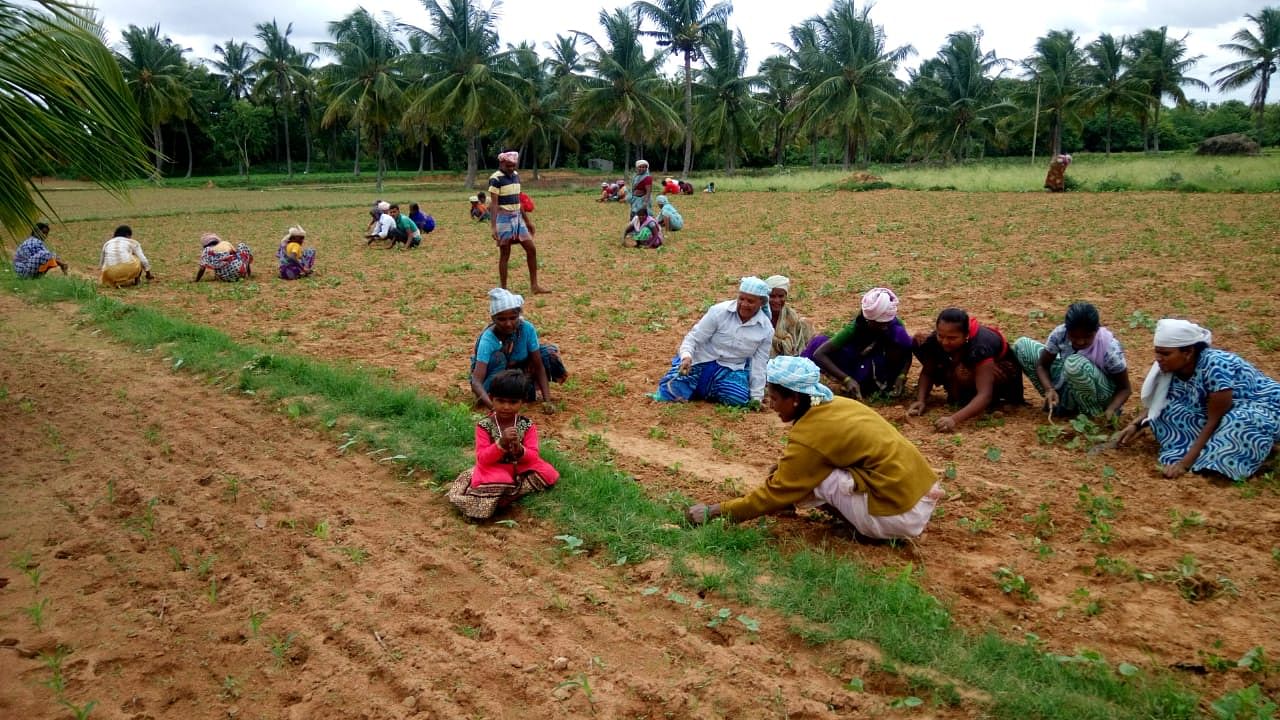
Credit: Special Arrangement
Bengaluru: Considering the mammoth tasks that a farmer faces at the start of every kharif season — de-weeding, tilling the land, adding fertiliser and then sowing — the sight of an empty parcel of land can be daunting. As prices of produce stagnate and the costs of labour rise, cultivation has become increasingly unviable. Set in this context, labour-sharing systems, formal and informal, can be key to continue practising agriculture. Evolved several generations ago, the ‘muyyalu paddhati’ is one such tradition, observed in rural communities across Karnataka.
Under the system, a village pools labour resources to complete a task. “In a village of 30 families, all the able-bodied members come together, right from preparing the land for cultivation to harvesting the land. People do not back out since they have a dependence on the tradition to cultivate their own land,” says Manjamma, a resident of a village in Tumakuru district.
The muyyalu system has much in common with the early barter system, explains Arun Joladakudligi, a folk researcher. “Many villages evolved systems that do not involve the exchange of cash, due to various reasons. Some of these exchanges started before the introduction of cash, others came into being because inflow was limited in these rural communities,” he says.
It is natural that even services such as agricultural labour are bartered, according to Girijamma, a Kadugolla farmer from Tumakuru district.
“If this year, we take pulses from a family, we make sure to return with a different commodity. Otherwise, in the coming year, we make sure to give pulses to the family,” she says.
The practice has remained in communities that are economically backward or geographically isolated — particularly tribal communities. In the Kadugolla community, for instance, barter systems still exist with essential commodities — food grain, vegetables and pulses.
Such systems apply not just to commodities and labour, but also to art. “For instance, if a group from village A went to village B during a significant occasion to sing devotional songs, village B will later send people to village A to sing,” explains Joladakudligi.
Community
Barter systems function on honour and therefore, can foster a real sense of community. Manjamma, a leader from the Kadugolla community, explains that fields come alive with conversation, local updates and even become sites of collaborative folk singing and storytelling. “People in my community prefer to work this way because one does not realise how the time passes. There is a real sense of togetherness and unity that comes in as well,” she adds.
Girijamma explains that time so spent in the fields also has a positive impact on the psyche. “Working alone or with just one other person can feel very isolating. When 10 to 15 people gather, this feeling dissipates. Also, we can share our joys and sorrows with people, and this lightens our burdens,” she says.
Apart from work, the group also breaks bread together. “As a gesture of gratitude, the person who owns the land that we are working on provides food, water and snacks. It is fun to eat together after working a long hard day,” she adds.
Relevance
As the input costs to agriculture rise steadily, the muyyalu system has come as a silver lining. “The cost of labour per day is Rs 400 to Rs 500. How can we recover anything after selling our harvest? We cannot even afford to grow our own food if we spend this much money on labour,” says Nagaraju, a Kadugolla farmer, who has exclusively used the muyyalu system to cultivate his land.
With no exchange of capital, the tradition provides an alternative for villagers to complete all agricultural tasks without working themselves to the bone. Today, however, the system is on the decline. “In villages that see a lot of migration, or ones that are economically well-off, this system is especially sparse,” says Joladakudligi.
There is also little ‘mixing’ of castes and communities, which prevents the true pooling of resources of current residents of villages. “For instance, privileged castes only pool resources if those offering the labour are also from the same caste,” he says. As a result, though the tradition has remained in pockets, it is practised within familial networks and almost exclusively under the constraints of the caste system.
On the whole, current practitioners of the tradition are certain that it could hold the key to ensuring a consistent supply of labour in the future. To
achieve this, it is essential to break the stronghold of the caste hierarchy, says Joladakudligi.